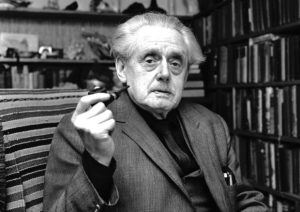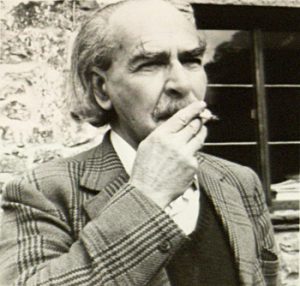Back in the 1950’s a group of like-minded conservative poets came together and decided that poetry should have rules. When I think of poetry the poets that stand out are the ones that make you think on another level and transport the reader into deeper thinking through imagery and symbolic meaning. The movement was against these prevalent ideas of romanticism of the time and wanted poetry to be structured and formal. To these modest fellas poetry should be based upon traditional devices in literature and included simple, sensuous content, and traditional form.
Thomas Hardy was the poetic model for The Movement because he was considered a realist.

How great my grief, my joys how few,
Since first it was my fate to know thee!
Have the slow years not brought to view
How great my grief, my joys how few,
Nor memory shaped old times anew,
Nor loving-kindness helped to show thee
How great my grief, my joys how few,
Since first it was my fate to know thee?
In this poem Thomas Hardy uses the triolet form: The triolet is a short poem of eight lines with only two rhymes used throughout. Thomas Hardy used this poem to appeal to emotions of seriousness and grief. Thomas Hardy was the go to man for their views because of his ability to write poetry in a structured and traditional way.
Out with the old in with The British Revival
Obviously this idea of playing it safe in poetry was just not cutting it anymore especially for the new and upcoming poets of the new decade. The British Revival was a movement that lasted from 1960’s-1970’s and their main goal was to bring back poetry that was based on progressive ideas and romanticism. The British Poetry Revival understood that poetry does not have a Judicial system and, there are no rules. So who is to say that the old way is the right way? This progressive movement focused more on poetry about imperfection and visual poetry that moved away from themes of structured and realist poetry.
Role Models of the British Revival
The British Revival looked to American poets like……….
 Ezra Pound
Ezra Pound  William Carlos Williams
William Carlos Williams
And British poets….
Hugh McDiarmid
Basil Bunting David Jones
Leading Poets of the British Revival period
The leading poets during this period were J. H. Prynne, Eric Mottram, Tom Raworth, Denise Riley and Lee Harwood. The features of their poems included:
1) Focus on the process of perception, consciousness, and putting into language in a poem rather than what is perceived or experienced.
2) Various forms of the estrangement effect, a device that prevents the audience from losing themselves completely into the character that is created by the actor, are added to enable focus on the language and process of the poem itself.
3) A sense of self-voice.
4) Improvisation or experimentation instead of a traditional form or pattern.
5) There may be aspects of performance in both the writing and the delivery of the text.
A sample of a leading poet’s poem: Errory by Tom Raworth
joined harmonising the best
so it needn’t wait
phrase: the question are you sure?
hanging three feet off the ground
silent, absolutely quiet
headquarters – we travelled north
clawing back small shelter
hung with screaming
on the same rig
blended in enthusiasm
as the race approached
through cracks in snow
free-falling into mind
alive with brightness shivering
One of the leading men of the British Revival Movement and one of the first poets to say making errors is okay. This different technique was very unique and modern to the old school poetry that previously was expressed. He was influenced by the Black Mountain poets, sometimes called projectivist poets, were a group of mid 20th century American avant-garde or post modern poets centered on Black Mountain college in North Carolina.
re·viv·al
rəˈvīvəl/
noun
noun: revival; plural noun: revivals
an improvement in the condition or strength of something.
By going against tradition and ideas of past poets it is safe to say that the British Poetry Revival accomplished exactly what they set out to do by making poetry purposefully flawed and unique. The poets of this time brought back to life the creativity in the art of poetry. By saying screw the rules they opened the door to various new styles of poetry and impacted poetry for generations to come.
British Poetry Revival Resources
“British Poetry Revival.” British Poetry Revival. N.p., n.d. Web. 31 Jan. 2017.
“British Poetry Revival.” Wikipedia. Wikimedia Foundation, n.d. Web. 31 Jan. 2017.
Finch, Peter. “Poetry Since 1945.” Continuum Encyclopedia Of British Literature (2003): 767-770. Literary Reference Center. Web. 7 Feb. 2017.
Hunter, Thomas Hardy – Poem. “”How Great My Grief” (Triolet) Poem.” PoemHunter.com. N.p., n.d. Web. 04 Feb. 2017.
“Thomas Hardy.” Wikipedia. Wikimedia Foundation, n.d. Web. 31 Jan. 2017.
SHEPPARD, ROBERT. “Chapter 2: The British Poetry Revival 1960-1978.” Poetry of Saying: British Poetry & Its Discontents, 1950-2000. 35-76. n.p.: Liverpool University Press 2004 Limited, 2005. Humanities International Complete. Web. 7 Feb. 2017.
“Triolet: Poetic Form.” Poets.org. Academy of American Poets, 29 Sept. 2004. Web. 04 Feb. 2017.




